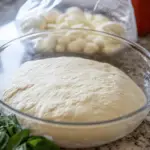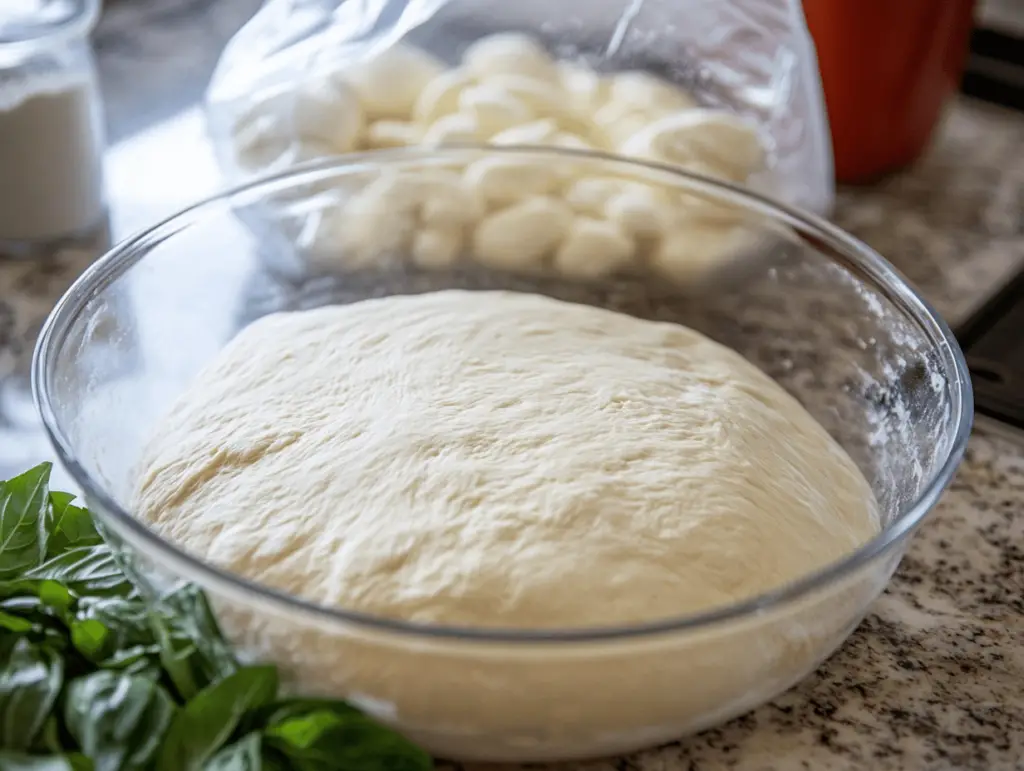There’s something undeniably magical about homemade pizza—its warm, crispy crust, rich and savory toppings, and the tantalizing aroma that fills your kitchen. With this simple pizza dough recipe, you’ll find it’s easier than ever to whip up a delicious pizza from scratch. Not only does making your own dough allow for customization to suit your tastes, but it can also be a fun culinary experience for you and your family. The process of pouring, mixing, kneading, and waiting for the dough to rise adds a personal touch that store-bought options simply cannot match. In this article, you’ll learn about the origins of pizza dough, the essential ingredients that yield a perfect crust, step-by-step instructions for making the dough, creative variations, serving suggestions, tips for success, and answers to frequently asked questions.
Understanding the Recipe
Pizza is a dish that has transcended its humble origins to become a beloved staple around the world. Originating in Naples, Italy, it initially consisted of flatbreads topped with tomatoes, cheese, and other local ingredients. The concept of pizza was embraced worldwide, evolving and transforming as it integrated different flavors and baking techniques from various cultures. This pizza dough recipe is simple yet traditional, utilizing basic ingredients which come together to create a dough that is both chewy and crispy, the perfect platform for any topping you desire.
For many, making pizza from scratch is a nostalgic experience that often conjures up memories of family gatherings and friendly gatherings. Whether it’s creating classic margherita pizzas or customizing personal pizzas with an array of toppings, this dough allows for versatility and creativity in the kitchen.
Ingredient Breakdown
Understanding the ingredients is key to mastering this pizza dough. Here’s a breakdown of what you’ll need:
- 1 cup warm water (107-110°F): This is essential for activating the yeast. The temperature is crucial; too hot, and you’ll kill the yeast, while too cold will delay its activation.
- 2 1/4 tsp active dry yeast: This is the leavening agent that helps the dough rise, creating a light and airy texture.
- 1 tbsp honey or sugar: This adds a touch of sweetness and nourishes the yeast, promoting a good rise.
- 1 tsp salt: Salt enhances the flavor and controls yeast fermentation, preventing the dough from rising too quickly.
- 2 tbsp olive oil: This adds richness to the dough and helps keep it tender. It also aids in browning and adds flavor.
- 3 cups bread flour (adjust for humidity): Bread flour has a higher protein content which contributes to a chewier crust. Depending on the humidity, you might want to adjust the amount here.
When assembling your ingredients, consider quality. Using high-quality yeast, flour, and olive oil can make a significant difference in the final product. For those with dietary restrictions, gluten-free flour can be used as a substitute for bread flour, although adjustments in the recipe may be necessary to achieve the best results.
Step-by-Step Instructions
Now that you’re familiar with the ingredients, here are detailed steps to create your own pizza dough:
- Activate the Yeast: In a bowl, combine 1 cup of warm water (107-110°F) with 2 1/4 tsp active dry yeast and 1 tbsp honey or sugar. Let this mixture sit for about 5-10 minutes until it becomes bubbly, indicating that the yeast is active.
- Mix the Ingredients: Once the yeast is bubbly, add 1 tsp salt and 2 tbsp olive oil to the mixture. Gradually incorporate 1 1/2 cups of bread flour initially. Stir until combined.
- Knead the Dough: Begin adding the remaining 1 1/2 cups of bread flour slowly, mixing until the dough reaches a slightly tacky consistency. Transfer the dough to a lightly floured surface and knead it for about 6 minutes until smooth. (Tip: If you have extra dough, consider freezing portions for later use!)
- Let the Dough Rise: Lightly grease a bowl and the dough to prevent sticking. Cover with a kitchen towel or plastic wrap, and allow it to rise in a warm area for 1-2 hours, or until it has doubled in size.
- Shape Your Pizza: Once the dough has risen, punch it down gently to remove any air bubbles. At this point, you can divide it into portions and roll it out to create your favorite pizza shapes and sizes!
Variations and Customizations
This pizza dough recipe is versatile, allowing for numerous variations:
- Herbed Dough: Incorporate dried herbs such as oregano or basil into the dough for additional flavor.
- Whole Wheat Option: Substitute part of the bread flour for whole wheat flour to enhance the nutritional value.
- Spicy Kick: Add red pepper flakes or garlic powder directly into the dough mixture for a spicy twist.
- Dairy-Free Option: Ensure that your toppings align with a dairy-free diet; the dough itself is already dairy-free as presented.
The customization possibilities are endless, so feel free to experiment and let your culinary creativity shine!
Serving Suggestions
A perfectly baked pizza deserves to be presented wonderfully. Here are some serving suggestions:
- Garnishes: Finish your pizza with a sprinkle of fresh basil or arugula before serving to add a pop of color and freshness.
- Sides: Serve with a simple arugula salad dressed lightly with olive oil and lemon for a refreshing complement.
- Beverage Pairings: Pair your pizza with a crisp white wine, a light beer, or a refreshing homemade lemonade.
- Occasions: This pizza dough is ideal for family dinners, casual gatherings with friends, or as a fun activity for kids on a weekend.
Tips for Success
To ensure that you achieve the best results with your homemade pizza dough, consider the following tips:
- Temperature Matters: Ensure that your water is at the right temperature for activating the yeast; using a kitchen thermometer is a great way to check.
- Kneading Technique: Make sure to knead the dough sufficiently; it should be smooth and elastic. Don’t skip this step!
- Rising Time: Allow the dough enough time to rise. If it is cold in your kitchen, consider placing it in a warm oven (turned off) to rise more effectively.
- Storage: Leftover dough can be stored in the refrigerator for up to 3 days. For long-term storage, freeze it wrapped tightly in plastic wrap and placed in a freezer bag. Bring it back to room temperature and allow it to rise before using.
FAQs
Here are some common questions people often have about this pizza dough recipe:
- Can I use instant yeast instead of active dry yeast? Yes, you can substitute instant yeast using the same amount. You can mix it directly with the dry ingredients without activating it first.
- What can I use if I don’t have bread flour? While bread flour is preferable for a chewier crust, you can use all-purpose flour as a substitute. The texture might be slightly different but still delicious.
- How can I make the dough rise faster? You can place the covered bowl in a warm, draught-free area. Avoid excessive heat, as this may over-proof the dough.
- What’s the best way to reheat leftover pizza? The best method is to reheat in a hot oven or skillet to retain a crispy crust. You can also use a microwave, but be aware that it may result in a softer crust.
Conclusion
This homemade pizza dough recipe demystifies the process of making one of the world’s most cherished dishes. With just a handful of ingredients and basic techniques, you can produce a lovely crust that’s perfect for any toppings you desire. The skills you learn here can lead to countless variations and adaptations tailored to your taste. We encourage you to embrace the joy of creating your own homemade pizzas and share your experiences with friends and family. Whether you choose to go classic or explore adventurous toppings, homemade pizza is sure to delight. So roll up your sleeves, gather your ingredients, and start your pizza-making adventure today!
Print
Easy Pizza Dough Recipe with Yeast
Description
Ingredients
- 1 cup warm water (107-110°F): This is essential for activating the yeast. The temperature is crucial; too hot, and you’ll kill the yeast, while too cold will delay its activation.
- 2 1/4 tsp active dry yeast: This is the leavening agent that helps the dough rise, creating a light and airy texture.
- 1 tbsp honey or sugar: This adds a touch of sweetness and nourishes the yeast, promoting a good rise.
- 1 tsp salt: Salt enhances the flavor and controls yeast fermentation, preventing the dough from rising too quickly.
- 2 tbsp olive oil: This adds richness to the dough and helps keep it tender. It also aids in browning and adds flavor.
- 3 cups bread flour (adjust for humidity): Bread flour has a higher protein content which contributes to a chewier crust. Depending on the humidity, you might want to adjust the amount here.
Instructions
- Activate the Yeast: In a bowl, combine 1 cup of warm water (107-110°F) with 2 1/4 tsp active dry yeast and 1 tbsp honey or sugar. Let this mixture sit for about 5-10 minutes until it becomes bubbly, indicating that the yeast is active.
- Mix the Ingredients: Once the yeast is bubbly, add 1 tsp salt and 2 tbsp olive oil to the mixture. Gradually incorporate 1 1/2 cups of bread flour initially. Stir until combined.
- Knead the Dough: Begin adding the remaining 1 1/2 cups of bread flour slowly, mixing until the dough reaches a slightly tacky consistency. Transfer the dough to a lightly floured surface and knead it for about 6 minutes until smooth. (Tip: If you have extra dough, consider freezing portions for later use!)
- Let the Dough Rise: Lightly grease a bowl and the dough to prevent sticking. Cover with a kitchen towel or plastic wrap, and allow it to rise in a warm area for 1-2 hours, or until it has doubled in size.
- Shape Your Pizza: Once the dough has risen, punch it down gently to remove any air bubbles. At this point, you can divide it into portions and roll it out to create your favorite pizza shapes and sizes!
